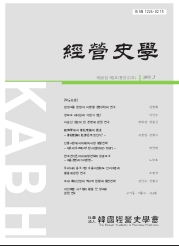- 영문명
- Characters of the native capitals in the Korean cotton industry under the colonial period (2)
- 발행기관
- 한국경영사학회
- 저자명
- Lee Han Koo(李漢九)
- 간행물 정보
- 『경영사연구(경영사학)』제13집 제1호(통권17호), 215~235쪽, 전체 21쪽
- 주제분류
- 경제경영 > 경영학
- 파일형태
- 발행일자
- 1998.06.30

국문 초록
영문 초록
Korean cotton industry was influenced by the industrialization of the Japanese cotton industry under the Japanese rule. At that time the most important issues of the Japanese cotton industrialization were export expansion of the cotton products and stable supply of raw materials, for example cotton, Therefore the industrialization of the Korean cotton industry was dependent on the modernized Japanese cotton industry.
The Korean cotton industry grew up in unequilibrium type, And the Korean cotton industry was developing into the compensating pattern to the Japanese cotton industry until 1919.
But this pattern was changed after 1920. Causes of the changing pattern were the establishment of Japanese modern cotton firms and the massive inflows of the native capitals on the Korean cotton industry between the the decade of 19205. These factors contributed to the equilibrium growth of the Korean cotton industry.
The leading group of the cotton industrialization was the native merchants. The native merchants grew up the entrepreneurial class by the business activity, And became the burgeoise. Some of the native capitals developed as the anti-colonial capitals, capitals, for example, Anju trading company and Chong-ro’s drapery merchants.
The 1920s was the most important periods for the industrialization of the Korean cotton industry.
목차
Ⅰ. 序論
Ⅱ. 植民地的 模作增産 强行
Ⅲ. 民族系 綿産業의 存在樣態
Ⅳ. 代表的 企業家 類型
Ⅴ. 結論
Abstract
해당간행물 수록 논문
참고문헌
최근 이용한 논문
교보eBook 첫 방문을 환영 합니다!

신규가입 혜택 지급이 완료 되었습니다.
바로 사용 가능한 교보e캐시 1,000원 (유효기간 7일)
지금 바로 교보eBook의 다양한 콘텐츠를 이용해 보세요!




